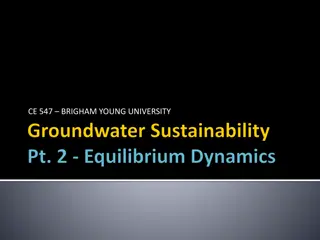Understanding Le Chatelier's Principle in Chemical Equilibrium
Le Chatelier's Principle states that when a system at equilibrium is disturbed by changes in concentration, temperature, or pressure, the equilibrium shifts to counteract the change. This principle can be applied to predict the direction of equilibrium when changes occur. Changes in concentration, pressure, and temperature influence the equilibrium position of reversible reactions. Adding or removing reactants/products, altering pressure, and adjusting temperature can impact the equilibrium state. Catalysts, however, do not affect the equilibrium position but accelerate both forward and backward reactions.
- Le Chateliers Principle
- Chemical Equilibrium
- Reversible Reactions
- Concentration Changes
- Pressure Effects
Uploaded on Jul 22, 2024 | 0 Views
Download Presentation

Please find below an Image/Link to download the presentation.
The content on the website is provided AS IS for your information and personal use only. It may not be sold, licensed, or shared on other websites without obtaining consent from the author. Download presentation by click this link. If you encounter any issues during the download, it is possible that the publisher has removed the file from their server.
E N D
Presentation Transcript
CLASS CLASS XI SUBJECT XI SUBJECT CHEMISTRY UNIT (CHEMICAL EQUILIBRIUM MODULE - 3/6 CHEMISTRY VII, EQUILIBRIUM (CHEMICAL EQUILIBRIUM UNIT VII, EQUILIBRIUM
Le Chemist presented a qualitative principle regarding reversible reactions. According to this If reaction is at equilibrium subjected to a change in anyone of the reaction parameters such as concentration, temperature or pressure, the equilibrium shifts in the direction that tends to undo the effect of the change Le Chatlier s Chatlier s principle: principle: He was a French
Le Chateliers Principle can be applied to predict the direction of the equilibrium when any change is done in reaction at equilibrium.
Change in concentration: amount of reactants or products are added to the system at equilibrium, the reaction will proceed in opposite direction where the change is done. In the same way when any molecule is removed from the system, the equilibrium will proceed to recover that. N2(g)+ 3H2(g) To get more amount of ammonia,we have to add more reactants i.e. nitrogen and hydrogen gas. Change in concentration: If any additional 2NH3(g)
Change in pressure is seen on those equilibrium where the reactants and products are gases. Since the gases are compressible, hence external pressure maters for such reactions. On increasing pressure a gaseous equilibrium shifts in the direction where the moles of the gases are less. This is also because of their less volume. N2(g)+ 3H2(g) On applying high pressure we can get more amount of ammonia. High pressure reduce the volume and concentration of reactants increase up to greater extent. Change in pressure: Effect of change of pressure 2NH3(g)
Change in temperature on those equilibrium where heat change takes place. In a reversible process if the forward reaction is exothermic, its backward reaction will be endothermic. On increasing temperature the equilibrium will shift in the direction where the process is endothermic and vice-versa. N2(g)+ 3H2(g) The process is exothermic in forward direction. Hence lower temperature will favor the formation of ammonia. Change in temperature: This change is effective 2NH3(g) ; H = -93.6 kJ
Effect of catalyst: forward and backward reactions at equal extent at equilibrium. Hence a catalyst does not affect the equilibrium of the reaction. Effect of catalyst: A catalyst speedup both
Effect of noble gas: with reactants or products directly. Its addition may affect pressure or volume of the system. At constant volume an inert gas has no effect on equilibrium. There is no change in concentration on either side of the reaction. At constant pressure volume increases and equilibrium shifts in the direction where number of moles of gases are more. 2SO3(g) Here equilibrium shift in forward direction. Effect of noble gas: A noble gas does not interact 2SO2(g) + O2(g)
Applications of Le principle is very useful in industries where manufacturing of chemicals going on. On the basis of this principle, most favourable conditions i.e. optimum conditions are decided. Manufacturing of ammonia by Haber s process, sulphuric acid by contact process are benefitted by Le Chatelier s Principle. Applications of Le Chatelier s Chatelier s Principle Principle: This























